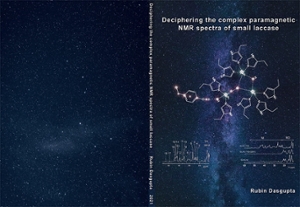Dissertation
Deciphering the complex paramagnetic NMR spectra of small laccase
Multicopper oxidase, laccase, can efficiently reduce oxygen to water and are mostly used in the enzymatic biofuel cells.
- Author
- Dasgupta, R.
- Date
- 15 June 2021
- Links
- Thesis in Leiden Repository

Multicopper oxidase, laccase, can efficiently reduce oxygen to water and are mostly used in the enzymatic biofuel cells. However, they suffer from low stability when functionalized over an electrode. This can be overcome by designing artificial catalysts for the oxygen reduction reaction based on the active site of laccase which requires a detailed understanding of the active site. The current research is aimed at characterizing the active site of small laccase from Streptomyces coelicolor using a combination of paramagnetic NMR spectroscopy, EPR spectroscopy, mutagenesis and quantum mechanical (QM) calculations. The presence of chemical exchange at the active site of laccase attributed to the coordinating histidines is reported. QM calculations showed the importance of the orientation of the coordinating water derived ligand. Mutagenesis study showed the importance of second shell residue in stabilizing intermediates during the oxygen reduction reaction. It is also reported that by changing the pH, a new intermediate could be experimentally observed however, further research is needed to characterize this. The resonance assignment shown in the current research can be used as spies to characterize the active site of laccase. This might in future provide insight into the catalytic mechanism of oxygen reduction reaction by laccase.
